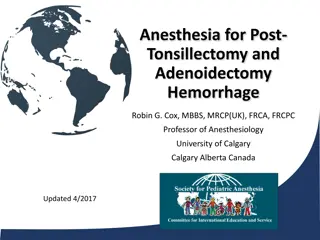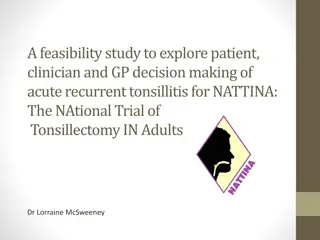Tonsillectomy
A detailed exploration into tonsillectomy, covering definition, purpose, risks, symptoms, complications, and preparation for the surgical procedure. Learn about when a tonsillectomy is recommended and the potential benefits it offers.
Download Presentation

Please find below an Image/Link to download the presentation.
The content on the website is provided AS IS for your information and personal use only. It may not be sold, licensed, or shared on other websites without obtaining consent from the author.If you encounter any issues during the download, it is possible that the publisher has removed the file from their server.
You are allowed to download the files provided on this website for personal or commercial use, subject to the condition that they are used lawfully. All files are the property of their respective owners.
The content on the website is provided AS IS for your information and personal use only. It may not be sold, licensed, or shared on other websites without obtaining consent from the author.
E N D
Presentation Transcript
StudyMafia.Org Tonsillectomy Submitted To: Submitted By: Studymafia.org Studymafia.org
Table Contents Definition Introduction About Tonsillitis Symptoms of Tonsillectomy Complications of Tonsillectomy Risks of Tonsillectomy Preaparation of Tonsillectomy Procedure of Tonsillectomy Conclusion 2
Definition Tonsillectomy (ton- sih-LEK-tuh-me) is the surgical removal of the tonsils, two oval-shaped pads of tissue at the back of the throat one tonsil on each side. 3
Introduction A tonsillectomy was once a common procedure to treat infection and inflammation of the tonsils (tonsillitis). Today, a tonsillectomy is usually performed for sleep-disordered breathing but may still be a treatment when tonsillitis occurs frequently or doesn't respond to other treatments. A tonsillectomy may also be necessary to treat breathing and other problems related to enlarged tonsils and to treat rare diseases of the tonsils. 4
About Tonsillitis The tonsils are the immune system's first line of defense against bacteria and viruses that enter your mouth. This function may make the tonsils particularly vulnerable to infection and inflammation. However, the tonsil's immune system function declines after puberty a factor that may account for the rare cases of tonsillitis in adults. 6
About Tonsillitis A tonsillectomy may be recommended to prevent frequent, recurring episodes of tonsillitis. Frequent tonsillitis is generally defined as: At least seven episodes in the preceding year At least five episodes a year in the past two years At least three episodes a year in the past three years 7
Complications of Tonsillectomy Tonsils may become enlarged after frequent or persistent infections, or they may be naturally large. A tonsillectomy may be used to treat the following problems caused or complicated by enlarged tonsils: Difficulty breathing Disrupted breathing during sleep (obstructive sleep apnea) 9
Complications of Tonsillectomy A tonsillectomy may also be used to treat other rare diseases or conditions of the tonsils, such as Cancerous tissue (malignancy) in one or both tonsils or suspected malignancy Recurrent bleeding from blood vessels near the surface of the tonsils Severe bad breath (halitosis) related to debris in the crevices of tonsils 10
Risks of Tonsillectomy Reactions to anesthetics: to make you sleep during surgery often causes minor, short-term problems, such as headache, nausea, vomiting or muscle soreness. Serious, long-term problems are rare, though general anesthesia is not without the risk of death. 11
Risks of Tonsillectomy Swelling. Swelling of the tongue and soft roof of the mouth (soft palate) can cause breathing problems, particularly during the first few hours after the procedure. Bleeding during surgery. In rare cases, severe bleeding occurs during surgery and requires additional treatment and a longer hospital stay. 12
Risks of Tonsillectomy Bleeding during healing. Bleeding can occur during the healing process, particularly if the scab from the wound is dislodged too soon. Infection. Rarely, surgery can lead to an infection that requires further treatment. 13
Preparation of Tonsillectomy Information you'll likely be asked to provide includes: All medications, including over-the-counter drugs and dietary supplements, taken regularly Personal or family history of adverse reactions to anesthetics Personal or family history of bleeding disorders Known allergy or other negative reactions to medications, such as antibiotics 14
Preparation of Tonsillectomy Instructions for preparing will include the following: Your doctor may ask you to stop taking some medications or change dosages of medications several days before the surgery. Don't eat anything after midnight before the scheduled surgery. Make arrangements for a ride home. Plan for 10 days to two weeks or more of recovery time. Adults may need more time than children do. 15
Preparation of Tonsillectomy Questions to ask your doctor or the hospital staff for yourself or on behalf of your child include: What are my dietary restrictions before surgery? When should I arrive at the hospital? Where do I need to check in? What prescription medications can I take in the days before surgery? When can I take the last dose? What is the expected recovery time? What restrictions to activities or diet should I expect during recovery? 16
Procedure of Tonsillectomy A tonsillectomy is used to treat: Recurring, chronic or severe tonsillitis Complications of enlarged tonsils Bleeding of the tonsils Other rare diseases of the tonsils The procedure may also be recommended if: A bacterial infection causing tonsillitis doesn't improve with antibiotic treatment An infection that results in a collection of pus behind a tonsil. 17
Procedure of Tonsillectomy Before the procedure A nurse may use a pre-surgery checklist of questions, such as asking you to say your name and the reason for your surgery. This is a standard procedure to ensure the safety of patients. 18
Procedure of Tonsillectomy During the procedure Because a tonsillectomy is performed under general anesthesia, you or your child won't be aware of the procedure or experience pain during the surgery. The surgeon may cut out the tonsils using a blade (scalpel) or a specialized surgical tool that uses heat or high-energy heat or sound waves to remove or destroy tissues and stop bleeding. 19
Procedure of Tonsillectomy After the procedure Common issues after a tonsillectomy include the following: Moderate to severe pain in the throat for one to two weeks Pain in the ears, neck or jaw Nausea and vomiting for a few days Mild fever for several days Bad breath for up to two weeks 20
Conclusion Tonsillectomies to treat recurring bacterial tonsillitis reduce the frequency and severity of strep throat and other bacterial infections. Tonsillectomies to treat viral tonsillitis have a smaller benefit. Tonsillectomies to treat obstructive sleep apnea and other conditions not related to infections can improve outcomes when other treatment strategies have not been beneficial. 21
Thanks To StudyMafia.org




